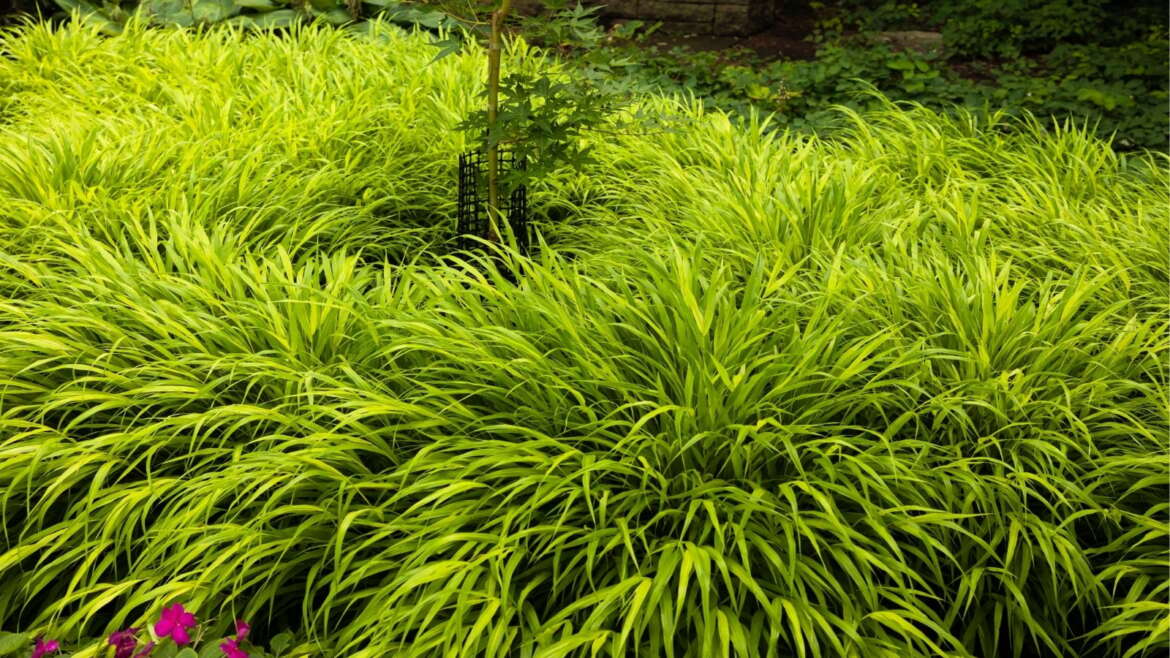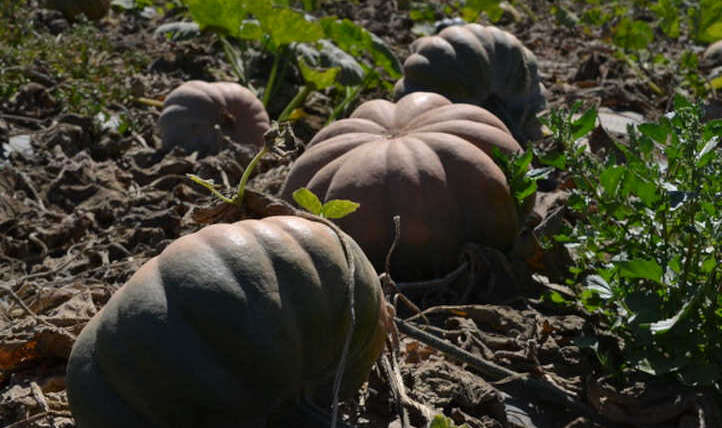Shade gardens are romantic, dramatic, lush, and criminally underrated. Lacking in showy blooms, shade gardens offer a reprieve from baking hot summer days and can be as rich in big, beautiful, bold shapes and colors as those in full sun. Japanese Forest Grass, also known as Hakone Grass and urahagusa or fuchiso in Japanese, is a perfect choice for adding texture and movement to the your shade garden.
Botanically known as Hakonechloa macra, the long, papery weeping blades of this shade-loving grass mimic bamboo leaves and gracefully arch down in what can only be described as a cascade. They look fabulous flowing down rocks and into paths. Even the slightest breeze causes a ripple in the leaves of Hakone grass, adding movement to the garden. While not the main show, insignificant six-inch yellowy-green floral spikes will appear in all cultivars in late summer.
Growing in well-drained and evenly moist humusy soil, the best thing about H. macra is its ease of care. This species will die back in winter. The best time to prune is in late winter or early spring. This is also a great budget-friendly option as the plant spreads by rhizomes and can be easily divided with a horticultural knife in spring and moved to containers, other parts of the yard, left to spread, or gifted to other admirers of this graceful grass.
Here are my 9 top picks for Japanese Forest Grass varieties.
Hakonechloa macra ‘All Gold’
‘All Gold’ exhibits golden hue in sunnier partial shade.
‘All Gold’ leads the list with chartreuse leaves that can brighten even the darkest of shade gardens with a nearly neon hue. This is one of the more popular varieties with a smaller, more upright, and slower-growing habit than other Japanese Forest Grass cultivars. In fall, the leaves turn to an ambery tan before dying back in winter. The nearly-black foliage of Heuchera ‘Primo Black Pearl’ is a bold and contrasting choice to pair with this lush variety.
While this grass is resistant to partial shade, deep shade will promote brighter chartreuse leaves, while sunnier partial shade will promote a golder hue. Either way, this is a striking specimen!
H. macra ‘Fubuki’
 This variety pairs wonderfully with dark green or deep purple foliage plants.
This variety pairs wonderfully with dark green or deep purple foliage plants.
Fubuki means “snowstorm” in Japanese and is a striking specimen with spring green leaves striped with white. This grass will also spice up the fall shade garden by transforming into shades of orange and bronze before dying back in winter. This particular variety tends to be shorter and more compact than other species of Japanese Forest grass, only growing to about 18 inches tall with an 18-inch spread.
Possible Pairings: Contrast with dark green or deep purple foliage such as Astilbe ‘Dark Side of the Moon’.
If you’re having trouble finding it on your plant search, note that ‘Fubuki’ is sometimes sold under the trade name ‘Briform.’
H. macra ‘Beni-kaze’
 The Benikaze Hakone grass is ideal for garden focal points.
The Benikaze Hakone grass is ideal for garden focal points.
Gradually transforming from a bright green in summer to spectacular shades of maroon in fall while still keeping some bright green fronds, ‘Beni-kaze’ is a striking Hakone grass. Plant this in a pot or area in the garden where its brilliant fall color show can be admired as a focal point. Some growers mention that the leaves turn to a brighter chartreuse when in deeper shade and a more golden hue when exposed to more sunlight in partial shade.
The big blue leaves of Hosta plantaginea ‘Blue Hawaii’ or Heuchera ‘Silver Gumdrop’ would compliment ‘Benikaze’ beautifully.
H. macra ‘Samurai’
 Pairing ‘Samurai’ grass with ‘Devon Green’ hostas highlights its variegation.
Pairing ‘Samurai’ grass with ‘Devon Green’ hostas highlights its variegation.
Another variegated Japanese Forest grass variety, ‘Samurai’ grows larger than other species. It forms up to two foot mounds of creamy white and bright green leaves that can be planted en masse or along pathways in the shade. The green stripes of ‘Samurai ’ are a brighter green than ‘Fubuki.’
‘Samurai’ can certainly stand on its own, but it looks nice with a strong pair. Try the shiny, saucer-shaped leaves of the Leopard Plant Farfugium Japonicum. Alternatively, the solid green leaves of ‘Devon Green’ hostas would showcase and complement the variegation of ‘Samurai.’
H. macra ‘Aureola’
 Golden variegated Aureola pairs well with Weeping Japanese Maples for a cascading effect.
Golden variegated Aureola pairs well with Weeping Japanese Maples for a cascading effect.
A recipient of the Royal Horticultural Society’s Award of Garden Merit, ‘Aureola’ resembles an elegant flowing fountain or waterfall with leaves that all manage to fall in the same direction. Its golden leaves are variegated with skinny creamy white stripes. Lime green in deep shade, increased sun exposure in partial shade turns the lime green to gold. In fall, the golden leaves fade to pink and red hues before dying back in winter.
Weeping Japanese Maple, such as Acer palmatum var. dissectum ‘Tamukeyama’ or ‘Waterfall’ are excellent pairings to continue the cascading look while staying in the Japanese plant realm.
H. macra ‘Stripe it Rich’
 This popular variety of Hakone grass complements red or purple foliage.
This popular variety of Hakone grass complements red or purple foliage.
Originating from a mutation in ‘All Gold,’ ‘Stripe It Rich’ has similar bright golden leaves but is variegated with white stripes. This is a compact variety in height at about 6 to 10 inches. It will spread over time to about 16 inches wide via underground rhizomes.
‘Stripe It Rich’ is one of the more popular varieties of Hakone Grass. It pairs beautifully with red or purple foliage like Heuchera ‘Forever Red’ or ‘Forever Purple.’
H. macra ‘Nicolas’
 This grass provides an ideal backdrop for showcasing various foliage.
This grass provides an ideal backdrop for showcasing various foliage.
‘Nicolas’ is a brilliant non-variegated variety of Hakone grass. A deeper green than other solid cultivars like ‘Benikaze’ or ‘All Gold,’ ‘Nicolas’ maintains the same flowing habit of other Hachonechloa macras. It is a great option for gardeners looking for a shade grass to fill in gaps or complement other foliage. In fall, ‘Nicolas’ shows off with vivid reddish-orange color.
Because of its solid color, ‘Nicolas’ creates the perfect backdrop to showcase foliage. Plant it with Japanese Painted Ferns or even diverse Hakone grasses in other colors or variegations.
H. macra ‘Naomi’
 ‘Naomi’ thrives in full to partial shade.
‘Naomi’ thrives in full to partial shade.
‘Naomi’ is a showstopper for fall color. In summer, it’s a yellow and green variegated variety that looks much like ‘Aureola.’ But, come fall, this plant shows out with brilliant purple foliage and small, insignificant brownish flowers in late summer. Like its cousins, ‘Naomi’ does best in full to partial shade.
In addition to Heucheras and Mondo Grass, the red flowers of Hellebore ‘Casade Blush’ are an excellent companion plant for ‘Naomi.’
H. macra ‘Albostriata’
 A variegated Hakone grass called ‘Albostriata’ shows increased cold tolerance in zone 4b.
A variegated Hakone grass called ‘Albostriata’ shows increased cold tolerance in zone 4b.
‘Albostriata’ is a variegated form with a mixture of thin white and cream chunky stripes. It grows up to 3 feet tall, much larger than other varieties and is more resilient to sun. These big grassy mounds look almost like masses of dwarf bamboo. Some growers report that ‘Albostriata’ is more cold tolerant than other Hakone grasses, so it may be an option for shady gardens in zone 4b.
Other shade-loving plants that complement ‘Albostriata’ could be Japanese Maples, hostas, or ferns.
Final Thoughts
Japanese Forest Grass is incredibly popular for good reason—its beauty in the shade garden, ease of care, movement, and texture, and adaptability as a focal point, gap-filler, or backdrop. Whether you love variegation or solid greens and golds, this gorgeous grass is great for landscape and container plantings.
Note that all companion plants mentioned in this article are simply suggestions. These plants can be mixed and matched to your heart’s desires! It’s hard to go wrong with Hakonechloa macra in the shade garden.




